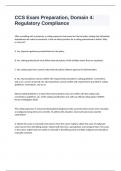CCS Exam Preparation, Domain 4:
Regulatory Compliance
After consulting with a physician, a coding supervisor has issued an internal policy stating that all bedside
debridement be coded as excisional. Is this an ethical practice for a coding professional to follow? Why
or why not?
A. Yes, physician guidance provided basis for the policy.
B. Yes, coding professionals must follow internal policies of the facilities where they are employed.
C. No, coding supervisors cannot make internal policies without approval of administration.
D. No, internal policies cannot conflict with requirements provided in coding guidelines, conventions,
and so on. correct answersD. No, internal policies cannot conflict with requirements provided in coding
guidelines, conventions, and so on.
Ethical Coding Guideline 1.2 states that internal policies may not conflict with the coding rules,
conventions, guidelines, etc. of the coding classifications nor with any official coding advice (AHIMA
House of Delegates 2016).
The coding supervisor is concerned that patients diagnosed with carcinoid colon tumors were miscoded
as malignant during the last six months. To address this situation, what work processes could be
undertaken?
A. Obtain the cases of carcinoid colon tumors from the cancer registry, obtain the cases of malignant
colon tumors from the billing system, import both lists into a spreadsheet, and compare them. The cases
in the cancer registry but not coded as carcinoid in the billing system are likely malignant and should be
manually reviewed.
,B. Compare the cases from the chart completion software with the billing software. Identify the cases
that are not in the billing system. These cases should be manually reviewed to ensure they are not
carcinoid tumors.
C. Obtain the cases of malignant colon tumors from both the cancer registry and the billing system;
import both lists into a spreadsheet and compare them. Identify correct answersC. Obtain the cases of
malignant colon tumors from both the cancer registry and the billing system; import both lists into a
spreadsheet and compare them. Identify the cases that are not in the tumor registry but are coded as
malignant in the billing system. These cases should be manually reviewed to ensure they are not
carcinoid tumors.
The diagnostic index can be used with the cancer registry data to undertake data quality analysis (Johns
2020, 85).
The patient was admitted for prostate carcinoma. This was treated with radiation. A member of the
medical staff who was not associated with the patient's care requests to see the patient's health record.
What should the coding professional do?
A. Provide the record to the physician.
B. Report the incident to hospital security.
C. Ask the physician to come back when the supervisor gets back.
D. Explain that providing the record would violate the privacy policy correct answersD. Explain that
providing the record would violate the privacy policy
This question relates to the need-to-know principle. The medical staff member who is not associated
with the patient's care does not need to see that patient's record (Hamilton 2020, 669-670).
Under which of the following circumstances does a healthcare entity lose a potential increase in
reimbursement when a hospital-acquired condition (HAC) is coded without a POA indicator of "Y"?
A. When the HAC is the only CC/MCC on the account
B. When the HAC is listed as the principal diagnosis
C. When the HAC is coded along with a surgical procedure
D. When the HAC is the only diagnosis listed correct answersA. When the HAC is the only CC/MCC on the
account
, It is only in the circumstance when the HAC is the only CC/MCC on the patient's account, and does not
carry a POA indicator of Y, will there be a loss of an opportunity to capture additional reimbursement
(Casto and White 2021, 85).
To correct an entry in a paper-based medical record, the provider should:
A. Draw a single line through the error, add a note explaining the error, initial and date, add the correct
information in chronological order
B. Draw a double line through the error, initial and date, add the reason for the correction
C. Draw a single line through the error, and add the correct information in chronological order
D. Draw several lines through the error, obliterate the documentation as much as possible, initial and
date, add the correct information in chronological order correct answersA. Draw a single line through the
error, add a note explaining the error, initial and date, add the correct information in chronological order
If an error is corrected, the healthcare provider who made the error should draw a single line through
the error, add a note explaining the error, initial and date it, and add the correct information in
chronological order (Sayles 2020, 78). Further, AHIMA principles for health record documentation specify
the prior statement as the proper method for correcting an error in the paper-based records in order to
maintain a legally sound record. This process is based on the ASTM and HL7 standards for error
correction (AHIMA e-HIM Work Group on Maintaining the Legal EHR 2005).
Most hospitals require a medical record to be completed within:
A. 5 days
B. 10 days
C. 7 days
D. 30 days correct answersD. 30 days
The Medicare Conditions of Participation and the Joint Commission require that the medical record is
completed no later than 30 days following discharge of the patient (Brickner 2020, 97).
What is the term used when protected health information has been disclosed inappropriately?
A. Exposure
B. Breach




